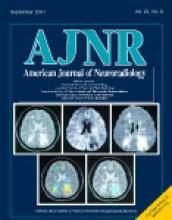Research ArticleBrain
MR Imaging in Comatose Survivors of Cardiac Resuscitation
Eelco F. M. Wijdicks, Norbert G. Campeau and Gary M. Miller
American Journal of Neuroradiology September 2001, 22 (8) 1561-1565;
Eelco F. M. Wijdicks
Norbert G. Campeau

Submit a Response to This Article
Jump to comment:
No eLetters have been published for this article.
In this issue
Advertisement
Eelco F. M. Wijdicks, Norbert G. Campeau, Gary M. Miller
MR Imaging in Comatose Survivors of Cardiac Resuscitation
American Journal of Neuroradiology Sep 2001, 22 (8) 1561-1565;
Jump to section
Related Articles
- No related articles found.
Cited By...
- Resting-State Brain Activity for Early Prediction Outcome in Postanoxic Patients in a Coma with Indeterminate Clinical Prognosis
- Anoxic Brain Injury Detection with the Normalized Diffusion to ASL Perfusion Ratio: Implications for Blood-Brain Barrier Injury and Permeability
- Assessment of Brain Glucose Metabolism Following Cardiac Arrest by [18F]FDG Positron Emission Tomography
- Discordant Observation of Brain Injury by MRI and Malignant Electroencephalography Patterns in Comatose Survivors of Cardiac Arrest following Therapeutic Hypothermia
- Part 8: Post-Cardiac Arrest Care: 2015 American Heart Association Guidelines Update for Cardiopulmonary Resuscitation and Emergency Cardiovascular Care
- Part 4: Advanced Life Support: 2015 International Consensus on Cardiopulmonary Resuscitation and Emergency Cardiovascular Care Science With Treatment Recommendations
- What to see when you are looking at confusion: a review of the neuroimaging of acute encephalopathy
- "Dazed and diffused": making sense of diffusion abnormalities in neurologic pathologies
- Teaching NeuroImages: Anoxic brain injury with unilateral hemispheric cortical involvement
- Ischemic Cerebral Damage: An Appraisal of Synaptic Failure
- Neuron-specific enolase correlates with other prognostic markers after cardiac arrest
- Hypoxic-ischaemic brain injury
- Part 9: Post-Cardiac Arrest Care: 2010 American Heart Association Guidelines for Cardiopulmonary Resuscitation and Emergency Cardiovascular Care
- Part 8: Advanced Life Support: 2010 International Consensus on Cardiopulmonary Resuscitation and Emergency Cardiovascular Care Science With Treatment Recommendations
- Temporal and Spatial Profile of Brain Diffusion-Weighted MRI After Cardiac Arrest
- Aetiological differences in neuroanatomy of the vegetative state: insights from diffusion tensor imaging and functional implications
- Post-Cardiac Arrest Syndrome: Epidemiology, Pathophysiology, Treatment, and Prognostication A Consensus Statement From the International Liaison Committee on Resuscitation (American Heart Association, Australian and New Zealand Council on Resuscitation, European Resuscitation Council, Heart and Stroke Foundation of Canada, InterAmerican Heart Foundation, Resuscitation Council of Asia, and the Resuscitation Council of Southern Africa); the American Heart Association Emergency Cardiovascular Care Committee; the Council on Cardiovascular Surgery and Anesthesia; the Council on Cardiopulmonary, Perioperative, and Critical Care; the Council on Clinical Cardiology; and the Stroke Council
- Practice parameter: prediction of outcome in comatose survivors after cardiopulmonary resuscitation (an evidence-based review): report of the Quality Standards Subcommittee of the American Academy of Neurology.
- Hemorrhagic infarction in white matter following acute carbon monoxide poisoning
- Magnetic resonance imaging abnormalities with septic encephalopathy
This article has not yet been cited by articles in journals that are participating in Crossref Cited-by Linking.
More in this TOC Section
Similar Articles
Advertisement











